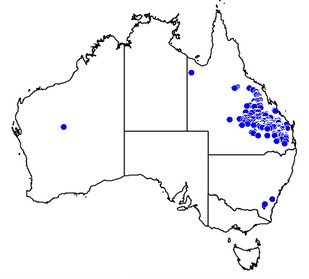Acacia bancroftiorum
Contents
General Plant Info
Until recently this species had been known as A. bancroftii ; however, as the name commemorates both Joseph Bancroft and his son, Thomas Lane Bancroft, the correct termination for the name is "-iorum".
Acacia bancroftiorum appears to hybridise with Acacia macradenia and Acacia falciformis in the Burnett and Leichhardt Districts respectively. The Acacia bancroftiorum x Acacia macradenia hybrids resemble Acacia holotricha.
This decorative species appears not far removed from the ‘ Acacia microbotrya group’.
Geographic distribution
Common from Collinsville S to near Crows Nest and W to near Tambo, also the White Mtns area, Qld. Usually grows in shallow soil on rocky hillsides in Eucalyptus woodland or open forest. Near Kingaroy it occurs in deep alluvium and its foliage is then usually green
Identification
Spindly shrub or slender tree to c. 6 m high. Upper branches often pruinose. Branchlets dark reddish, often pruinose, glabrous.
Phyllodes obliquely obovate to narrowly elliptic, curved near the much-narrowed base, 9–22 cm long, 2.5–8 (–16) cm wide, obtuse, usually glaucous, glabrous; midrib prominent and ±excentric; minor nerves forming an open reticulum; gland 0–4 mm above pulvinus, the pore narrow and elongated (often slit-like), 1–3 additional glands on triangular projections sometimes present; pulvinus 5–12 mm long.
Inflorescences racemose, sometimes paniculate; raceme axes 3–8 cm long, sometimes longer, glabrous, sometimes appressed-puberulous; peduncles 5–8 mm long, glabrous, sometimes appressed-puberulous; heads globular, 25–40-flowered, pale lemon yellow or golden. Flowers 5-merous; sepals c. 5/6-united.
Pods to 22 cm long, 9–15 mm wide, thinly coriaceous, slightly pruinose, glabrous.
Seeds longitudinal, oblong to elliptic, 6–9 mm long, ±dull, black; funicle encircling seed in a single fold, thick, reddish brown; aril linear-clavate.
Specimens with hairy raceme axes and peduncles occur in the south-east of the range and are distinguished from Acacia falciformis by gland position and morphology. Glands also serve to distinguish the species from Acacia penninervis where ( Acacia falciformis also) the margin is often shallowly indented at the gland which is connected to the midrib by a fine oblique nerve. Resembles Acacia wardellii.
Alkaloid content
Other uses
Extraction
Cultivation
Site – about 200m down a 1 in 20 slope, light shade from eucalypts.
Soil – shallow(less than 60cm) duplex soil over granite which dries rapidly but is waterlogged after heavy rain. The topsoil is sandy and the subsoil light clay.
Annual rainfall – 700mm mainly in summer Frost – hardy to –5 degrees (the coldest registered there)
Drought – no problems with a drought period of less than 100mm of rain in 6 months
Comments – the phyllodes on these plants are green and almost uniformly narrow as opposed to the high percentage of broad grey green phyllodes present on plants cultivated on the crest of the ridge.
Only young plants growing on this site have that type of foliage. The flowers are bright yellow as opposed to the pale yellow to cream usually described. These plants are 5 years old and about 4m high.
Suppliers
Links
http://www.worldwidewattle.com/speciesgallery/bancroftiorum.php
